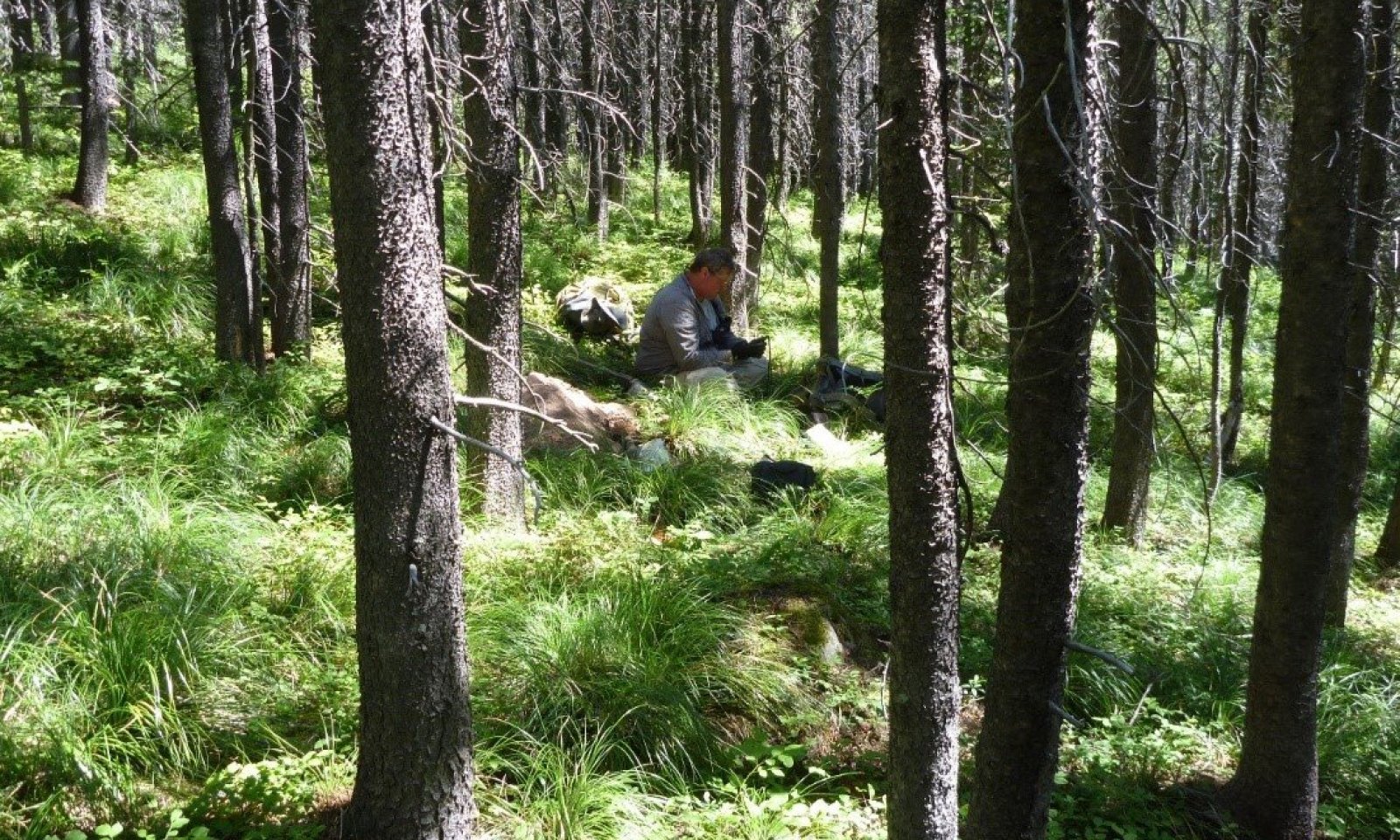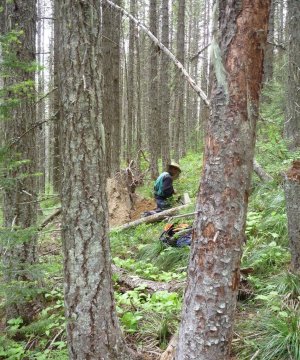
Subalpine Coniferous Cool Moderately Dry subalpine fir (Abies lasiocarpa) / Engelmann spruce (Picea engelmannii)
Scenario model
Current ecosystem state
Select a state
Management practices/drivers
Select a transition or restoration pathway
- Transition T1A More details
- Restoration pathway R2A More details
-
No transition or restoration pathway between the selected states has been described
Target ecosystem state
Select a state
Description
Subalpine fir (Abies lasiocarpa) and, to a lesser amount, Engelmann spruce (Picea engelmannii), are the dominant overstory species with lodgepole pine (Pinus contorta) and Douglas-fir (Pseudotsuga menziesii) as the seral dominants with lesser amounts of western larch (Larix occidentalis) and western white pine (Pinus monticola). Whitebark pine (Pinus albicaulis) may be present, but these sites are not cold enough to give it a competitive advantage and therefore it is a minor component. The main understory species is the indicator species beargrass (Xerophyllum tenax), with the medium-sized shrub thinleaf huckleberry (Vaccinium membranaceum), grouse whortleberry (Vaccinium scoparium), and minor amounts of Oregon boxleaf (Paxistima myrsinites) and other understory species of pinegrass (Calamagrostis rubescens), Geyer’s sedge (Carex geyeri), broadleaf arnica (Arnica cordifolia), western meadow-rue (Thalictrum occidentale), and sidebells wintergreen (Orthilia secunda). This ecological site is associated to the subalpine fir/rusty menziesia ecological site on moist exposures, subalpine fir/Hitchcock’s smooth woodrush ecological site on higher elevations, and Douglas fir/thinleaf huckleberry on drier and warmer sites. Historically, this site would have had minor amounts of western white pine as a seral species before this species was decimated by the white pine blister rust epidemic (McDonald et al., 2000).
This ecological site is described as having cool and moderately dry site conditions, with a fire return interval of 50-130 years, and with fire typically of low to moderate fire intensity. This fire regime favors species such as lodgepole pine, Douglas-fir, and western larch, although subalpine fir and Engelmann spruce dominate in later successional phases. The shorter fire return interval and moderate fire intensity allow the more fire resistant Douglas-fir to be a major successional species in many stands. Douglas-fir is also able to successfully regenerate in fire-created openings where mineral soil has been exposed. Stands that are dominated by lodgepole pine and over 80 years old tend to build fuels to become a part of large stand-replacement events encompassing thousands of acres. Stand-replacement fire occurs in patches of 200 to 2,000 hectares (McDonald et al., 2000). Stand-replacement fires generally allow lodgepole pine to regenerate although some large, thick barked Douglas-fir will often survive. Stands generally have relatively large amounts of downed woody fuel, especially in those with trees over 8 cm or 3 inches in diameter. Dense understories and live fuel also help to carry fire into the tree crowns during dry conditions. Relatively deep duff layers can form and, when dry conditions exist, aid in fire spread and mortality by heating the shallow roots of subalpine fir and Engelmann spruce.
The general post-disturbance successional phases include the stand initiation phase dominated by herbaceous and shrub species and conifer seedlings, the competitive exclusion phase of dense pole-sized mixed conifer or single seral species, the maturing forest of overstory mixed conifer trees with or without patches of regeneration and the Reference phase dominated by subalpine fir and Engelmann spruce with small gap dynamics. Underburns, which affect the understory shrub and herbaceous species and conifer regeneration the most, can occur and maintain any community phase. A stand-replacement fire in the mature forest or Reference phase would result in the stand initiation phase, with species composition of seedlings varying with site conditions and seed source. Moderate fires (or mixed severity fires) in the competitive exclusion phase would favor the more fire-resistant Douglas-fir, western larch or western white pine over lodgepole pine, Engelmann spruce, and subalpine fir. Therefore, these species would dominate the maturing forest phase for a longer period of time. After a stand-replacement fire at this stage, with serotinous lodgepole pine present, then their seedlings would dominate the seedling and competitive exclusion phases. Absence of fire will transition the competitive exclusion phase to a mature forest dominated in the overstory by a mix of conifer species. Severe fire at this stage could remove much of Douglas-fir, leaving the site to be regenerated by either serotinous lodgepole pine or remnant western larch. Severe fires that remove even western larch will return to the treeless stand initiation phase. If fire does not occur in the forest maturing phase, then this will continue into the Reference phase.
Significant fires that have occurred on the west side of the Continental Divide that affected this ecological site are the 1994 Starvation Creek fire, caused by lightning, which burned 7,202 acres in Glacier NP. The Wedge Canyon fire in 2003, which burned 30,314 acres in Glacier NP, and 53,359 total acres, was also caused by lightning. The Red Bench fire in 1988 burned 27,500 acres in Glacier NP and 36,037 total acres, and also was started by lightning. The 2003 Robert fire was caused by humans and burned 52,747 acres, 39,384 of which were in Glacier NP. The Rampage fire, caused by lightning in 2003, burned 21,630 acres in Glacier NP and the 1994 Adair fire burned 9,753 acres in Glacier NP. The Wolf Gun fire in 2003 burned 14,663 acres in Glacier NP.
Both subalpine fir and Engelmann spruce are subjected to a variety of diseases and insect pests including root rot, stem decay, bark beetles, and wood borers and defoliators. These can weaken and or kill trees, which results in small openings scattered throughout the forest, or major mortality during an outbreak such as western spruce budworm (Choristoneura occidentalis). The patterns of damage from endemic populations of insects and disease creates small openings, whereas epidemic patterns are extensive throughout the landscape. Windthrow commonly can cause additional damage to stands following disease and pest disturbance. Subalpine fir is most commonly susceptible to Armillaria and Annosus root disease, pouch, Indian paint, and red belt fungi which cause stem decay, metallic, roundheaded and western balsam bark beetle, fir canker, and defoliators such as Delphinella shoot blight, black mildew, brown felt blight, fir needlecast, snow blight, and fir-blueberry rust. Engelmann spruce is most commonly susceptible to Annosus and Schweinitzii root disease and butt rot, pini rot, stem decays by red belt fungus, metallic and roundheaded borers, spruce beetle, blue stain of sapwood, spruce broom rust, spruce canker, and brown felt blight.
Aerial photography is a good tool to use to discern the level of insect and disease and the damage patterns and whether these are at endemic or epidemic levels. These maps capture only moments in time and infestations grow and move from location to location following their preferred habitat, so repeated photography can be necessary. Specifically for the northern region, the USFS Stand Health map (Aerial Detection Survey maps) shows that the major impact is defoliation by western spruce budworm. The defoliation was categorized as mostly low severity (equal to or less than 50 percent defoliation) and some as high severity (with greater than 50 percent defoliation) on Abies species, and the damage is contiguous or nearly continuous. The forest type was categorized as western Fir-Spruce type. There also was defoliation by western spruce budworm on Douglas-fir, but to a much lesser degree. Larch casebearer, a defoliator of western larch and generalized needlecast of western larch, also was found to a much lesser degree. Scattered small areas were found throughout the region including mortality from mountain pine beetle on lodgepole pine, Douglas-fir beetle on Douglas-fir, spruce beetle on Engelmann spruce, fir engravers and Woolly adelgid on ABIES spp., and general subalpine fir mortality. Both of these would affect this ecological site, and field notes corroborate these findings.
Submodel
States 1 and 5 (additional transitions)
1.1. Reference Plant Community
1.5. Vertical Differentiation in Stand
Description
Another disease affecting this ecological site is root rot. Armillaria root disease is the most common root disease fungus in this region, especially prevalent west of the Continental Divide. It may be difficult to detect until it has killed enough trees to create large root disease pockets or centers, ranging in size from a fraction of an acre to hundreds of acres. The root disease spreads from an affected tree to its surrounding neighbors through root contact. The root disease affects the most susceptible tree species first, leaving less susceptible tree species that mask its presence. When root rot is severe, the pocket has abundant regeneration or dense brush growth in the center. In western Montana and northern Idaho, Armillaria is present in most stands with diffuse mortality and large and small root disease centers. The disease pattern is one of multiple clones merging to form essentially continuous coverage of sites. Grouped as well as dispersed mortality can occur throughout the stand. A mosaic of brushy openings, patches of dying trees, and apparently unaffected trees may cover large areas. There can be highly significant losses, usually requiring species conversion in the active management approach. Management tactics include identify the type of Armillaria root disease present, and manage for pines and larch. Pre-commercial thinning may improve growth and survival of pines and larch. Avoid harvests that leave susceptible species (usually Douglas-fir or true firs) as crop trees (Hagle, 2010). A link has been determined between parent material and susceptibility to root disease, and metasedimentary parent material is thought to increase the risk of root disease. Glacier NP is dominated by metasedimentary parent material and may be more at risk than other areas to root disease (Kimsey et al., 2012). If a stand sustains very high levels of roots disease mortality, then a coniferous stand could cross a threshold and become a shrubland, once all conifers are gone (Kimsey et al., 2012).
Submodel
Model keys
Briefcase
Add ecological sites and Major Land Resource Areas to your briefcase by clicking on the briefcase (![]() ) icon wherever it occurs. Drag and drop items to reorder. Cookies are used to store briefcase items between browsing sessions. Because of this, the number of items that can be added to your briefcase is limited, and briefcase items added on one device and browser cannot be accessed from another device or browser. Users who do not wish to place cookies on their devices should not use the briefcase tool. Briefcase cookies serve no other purpose than described here and are deleted whenever browsing history is cleared.
) icon wherever it occurs. Drag and drop items to reorder. Cookies are used to store briefcase items between browsing sessions. Because of this, the number of items that can be added to your briefcase is limited, and briefcase items added on one device and browser cannot be accessed from another device or browser. Users who do not wish to place cookies on their devices should not use the briefcase tool. Briefcase cookies serve no other purpose than described here and are deleted whenever browsing history is cleared.
Ecological sites
Major Land Resource Areas
The Ecosystem Dynamics Interpretive Tool is an information system framework developed by the USDA-ARS Jornada Experimental Range, USDA Natural Resources Conservation Service, and New Mexico State University.



